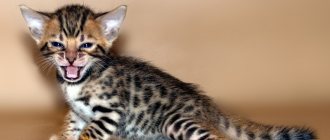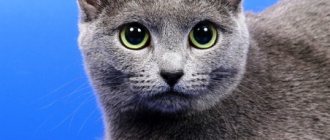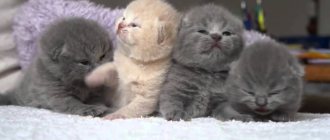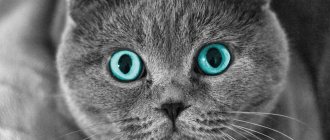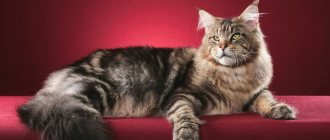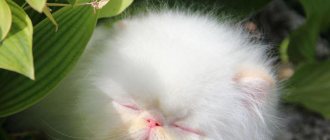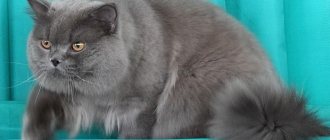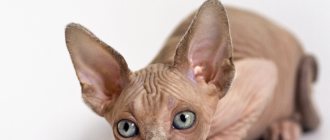Preparing a place for a kitten
The cat's bed should be set up away from drafts, slamming doors, consumer electronics (including computer units) and sources of any loud sounds. These requirements are especially relevant when you offer your pet a rug instead of an autonomous house . Of course, a small Burmese will sleep on any soft fabric (towel, blanket), but as it grows, it is better to purchase or sew an oval/round bed with high sides.
Burmese cats (like many others) like to often change position and stretch out in their sleep, which is why they need a spacious bed, limited by sides for comfort. If the Burmese doesn’t like the house/bed, she won’t sleep there, but will choose a more comfortable place, for example, on the owner’s sofa.
You don’t have to worry too much about the toilet for a Burmese cat: any tray will do for her (with or without filler), the main thing is that the animal is not constrained in its movements when fulfilling its natural needs.
Another indispensable attribute of a cat’s life, as well as your peace of mind, is a scratching post, which you can also build with your own hands. The Burmese are taught to use this weapon from childhood, so as not to one day encounter torn wallpaper and scratched furniture.
Return to content
Ready-made pet food
Natural food is the most suitable option for a cat. A nutritious diet contributes to the normal functioning of the animal’s body. On the other hand, owners do not always have the time and experience to prepare this kind of food. Moreover, food spoils quickly. Ready-made food, which is freely available in veterinary pharmacies, comes to the rescue. High quality food is filled with essential minerals and vitamins, it has a long shelf life and is selected according to the age and health of the cat.
You need to carefully approach the choice of food, taking into account the preferences and needs of your furry pet. Observe your pet's reaction, especially the growth and condition of its fur and stool. Stick to one type of food - changing it frequently can lead to negative consequences and deterioration of the animal’s body condition.
The desires of your Burmese are the main guide in finding food. Research the ingredients and don't rely on advertising campaigns. Discounted and inexpensive food can be dangerous to a cat’s health, so give preference to high-quality and more expensive products. Healthy nutrition is the key to your pet’s well-being.
Caring for a Burmese cat
The weakest points of the Burmese (individual breed lines) are considered to be the eyes, nose and teeth. Otherwise, all care procedures are not much different from standard manipulations with other cats.
Cleaning ears, eyes, nose
Due to the structure of their faces, modern Burmese cats often suffer from increased lacrimation, so their eyes are regularly cleaned of discharge using a cotton pad or swab with a mild antiseptic.
For sore eyes, use drops:
- tsiprovet;
- iris;
- maxitrol.
If symptoms persist, contact a clinic.
Important! Short-nosed American Burmese, more than European ones, are prone to runny noses, so owners of the former should pay increased attention to the free breathing of their pets and the cleanliness of their nasal passages.
The ears are examined once a week, removing excess wax with a moistened cotton pad. Ear care will be made easier by drops that your doctor will recommend. If a cat constantly scratches and even tears its ear, it means that ear mites have settled there, which must be removed with special drops.
Grooming
The Burmese cat has a close-fitting, short and very smooth coat that is easy to care for. Brush your Burmese once a week with a silicone/rubber mitten or a regular brush - this will be enough.
If you want to add shine to the coat, go over it (after brushing) with suede or silk. Before a show, as well as during shedding periods, cats are brushed a little more often.
Professional hair care will be provided by a device such as a furminator . It is not very cheap, but it effectively removes dead hair, making the fur of the Burmese cat even more well-groomed and shiny.
Care for claws and teeth
Look into your pet's mouth often, as Burmese cats have been shown to have a hereditary predisposition to gum inflammation (gingivitis). The examination should be accompanied by teeth cleaning, preferably once every 7 days.
Important! If you find tartar, take the Burmese to the hospital: the dentist will remove the stones and at the same time treat teeth affected by caries. Self-removal of tartar is not recommended, since at home it is easy to infect the mucous membranes.
Some owners regularly, but not more than once a month, trim their Burmese's claws. To do this, they use nail clippers, cutting off 1-2 mm from the claw, trying to get around the pulp. The procedure requires skill and self-control, so if you are unsure of your own abilities, it is easier to turn to a groomer.
Bathing and washing
If your Burmese does not clean chimneys and sits at home, it is better to leave it alone and not subject it to water procedures without a reason, which could be participation in an exhibition or noticeable pollution. The coat of the Burmese cat is impervious to dirt; moreover, the breed is characterized by increased disgust and a desire for cleanliness.
If you really want to bathe your Burmese, do it about once a quarter using shampoo for short-haired cats. When bathing, protect her ears by covering them with cotton wool and showering only her body: gently wash her head with your hand. To avoid drying out the Burmese's skin, after bathing, pat its coat dry with a soft towel and skip the hairdryer, giving you the opportunity to clean yourself up away from the draft.
Return to content
Games and toys for kittens
Having settled in a new place, the kitten will begin to play with pleasure, using any objects that come to hand: pieces of paper, laces, curtains, etc. Purchase moving toys, balls, rubber mice, etc. in advance. It is important that the toys do not contain small parts that can be chewed off, since the kitten will certainly have such a desire. By the way, after playing, a kitten can use its claws and teeth when in contact with a person; such actions should be stopped immediately by making a warning sound.
Cats of the Burmese breed have regal plasticity, moving easily and gracefully, developed muscles allow them to perform incredible somersaults, stand for a long time, in a word - put on a real “show” during games. It’s a good idea to buy a special complex for your kitten, where he can climb and jump to his heart’s content, developing dexterity and flexibility.
Diet features
It is worth considering that the Burmese cat always has a good appetite, which is why fat deposits on the sides are deposited very quickly . This is not welcomed by the standard, since the Burmese, although called “a brick wrapped in silk,” is obliged to look elegant and harmonious.
That is why the diet of Burmese cats should contain only high-quality food (holistic and super-premium) with a high concentration of animal protein and vitamins. The active components of such foods help maintain excellent muscle tone and shiny coat, which is considered the hallmark of the breed.
This is interesting! Tomatoes and strawberries (if the cat does not suffer from allergies), as well as solid food that prevents deposits on teeth, will help prevent gingivitis and the formation of tartar.
The Burmese natural menu includes:
- meat (raw and cooked);
- sea fish (fresh and boiled);
- fermented milk products (without fruit fillers);
- chicken eggs;
- vegetables (in any form);
- liver (fresh/boiled);
- porridge.
A natural diet requires vitamin and mineral supplements, which are mixed with ready-made meals. Adult Burmese are fed twice a day, adolescents - three times, pregnant cats and small kittens - four times a day.
Don't forget about the right dishes: it is better to use stable bowls made of ceramic or thick glass. Some metal cups give water/food a bad taste, and plastic not only smells bad, but also contains toxic substances.
Return to content
Carbohydrate-rich foods
Hercules porridge, buckwheat, rice and other grains are enriched with carbohydrates. The diet of Burmese cats should include sprouted wheat grains and legume seeds. Giving fruits and vegetables is beneficial, but not all pets like them. Before feeding, chop carrots, dill or apples into a pulp. If the cat does not want to eat food raw, try boiling it.
Vitamins and mineral components
Grass must be included in your pet’s diet. You can grow oats at home. First, pick up a small container filled with sawdust. Then moisten the soil and spread the oats. When the grains grow to 11 centimeters, give them to your cat to try. The best option is to periodically grow grass in 1-2 places at once, so that the Burmese always has “green” vitamins. The grass has a large amount of vitamins and useful elements; it is necessary for the life of the pet.
Yeast is given as additional substances, but they should not be abused. Moreover, some cats may experience an allergic reaction. Veterinary pharmacies also offer a wide range of mineral supplements for the body of four-legged animals, but you need to choose such complexes in accordance with the cat’s condition. Overdose leads to undesirable consequences.
Feeding frequency
Small Burmese kittens, 2-3 months old, are fed about six times a day in tiny meals. The number of meals is 4-5 times a day if the pet is from 3 to 5 months old. On average, six-month-olds are fed three times. For an adult Burmese, two meals a day are appropriate. Do not feed your pet only once a day, because even wild cats eat several times, constantly hunting and satisfying their hunger.
Set a specific time for your cat to eat and stick to it from day to day. If the pet is free-range, it will always appear near the house at the same hour for feeding. Serve food warm in a quiet and secluded place. Buy several bowls if there is more than one cat in the house - each one needs a separate container for food.
Be sure to make sure that your pets eat their portion and do not steal from each other. It is best to feed dogs in separate rooms from cats - their hunting instincts lead to aggression.
Cats that roam freely 24/7 also need to be fed, even if they catch a variety of rodents. Owners are obliged to regularly feed their pets, because often cats do not eat caught mice.
Remember: after a full meal, furry four-legged animals love to take a nap - take care of their cozy sleep.
Diet for Burmese cats
An important condition is monitoring the well-being and physical indicators of the pet. During feeding, you should adhere to certain rules. Firstly, a pregnant Burmese needs frequent meals, portions should be twice as large as usual. The same applies to cats during lactation. Producer cats are given protein products and food enriched with vitamin E.
If your pet is not young, doesn’t move around much, and doesn’t have sharp teeth, you should feed it in small doses. A light meal or appropriate food will do. Neutered cats are sometimes inactive and suffer from poor metabolism, which causes obesity. In this case, carefully monitor your diet. Cats suffering from various diseases require special care, consultation with a veterinarian and a special diet.
Diseases, breed defects
Due to their different anatomical structures, American and European Burmese are somewhat different in the set of typical genetic ailments . Thus, modern-type Burmese are free from the dangerous hereditary disease GM2-Gangliosidosis, which is found among classic Burmese cats. The disease begins with loss of coordination, develops rapidly, flowing into paralysis, and ends with the death of the animal. The difficulty is that the disease, although congenital, manifests itself at 3 months of age, when the kitten finds a new owner.
Burmese are often diagnosed with hypokalemia (lack of potassium), which is evidenced by such initial symptoms as lethargy and increased fatigue. To prevent the disease from ending in paralysis, the cat is given potassium or added to the food. Burmese kittens are sometimes born with FCKS (flat chest syndrome), where not only the sternum is deformed, but also the ribs.
This is interesting! Burmese with FCKS overcome two crises, on the 10th and 21st days. A baby who survives for more than 3 weeks usually lives a normal cat life, regardless of the correction of the sternum.
Due to the shortened nose (and short nasal passages) of the American Burmese, the owner is obliged to protect it from hypothermia and colds that cause a runny nose. In addition, the following are recognized as genetic diseases of the Burmese cat:
- endocardial fibroelastosis;
- eye diseases, including erosion of the third eyelid cartilage;
- lethal defects of the midfacial zone;
- dry eye syndrome;
- herniation of the meninges/brain;
- diabetes;
- skull deformation;
- orofacial pain syndrome.
Certain lines of European Burmese have difficulty giving birth and have a high risk of caesarean section. In contrast, modern Burmese cats give birth easily and require almost no surgical intervention during childbirth.
Return to content
Buy a Burmese kitten
global $ads_google;
//data-ad-slot=”2475549904″ $ads_google = empty($ads_google) ? false : true; ?> if ($ads_google == false) {?> $ads_google = true; ?> } ?> Since the Burmese breed is quite widespread in the world, buying a kitten will not be so problematic. The main selection criterion is to purchase a cat in a nursery, and not a cat in a poke on Avito. Kittens from nurseries at 3 months are already litter box trained, have completed vaccination and quarantine courses, switched to cat food and are completely healthy.
The average price for Burmese kittens in Russia is 20,000 rubles.
Conclusions about the breed
The Burmese cat is an amazing animal from Southeast Asia. Among her undoubted advantages are not only her pretty appearance and innate grace, but also her friendly character. Thanks to him, the pet finds a common language with all the inhabitants of the house. The Burmese is unusually playful and active. It seems that she only stops when she is planning her next entertainment.
The main thing a cat needs is the attention and love of its owner. But he, in turn, must repay the affection, caresses and unobtrusive purring by creating all the conditions for the healthy development of his pet. Not only proper nutrition is important, but also regular coat care, which does not take much time.
Raising a Burmese cat
Cat trainers have long paid attention to the Burmese with their attractive appearance, artistry, increased IQ, desire to always be in the center of attention and please a person. Circus performers know that training a Burmese is an entire art, since the cat remembers its natural behavior patterns, which must either be supported or weakened . After the peculiar behavior of the Burmese is accentuated and consolidated, you just need to come up with a scene where the cat will look most organic and impressive.
In turn, biologists have found that motivation for cats is much more important than for dogs: the Burmese must want to express itself in a certain way. If a dog needs a treat to reinforce a skill, it does not work in the case of a cat: the latter comes from its love for its owner and the desire to play.
British researchers have also found that a cat's sociability, as well as the degree of its trustfulness towards humans, is genetic and inherited on the paternal side. And since the cat’s father never participates in the upbringing of his children, the British conclusion has so far become the only evidence of the influence of the male on the offspring.
Important! The most favorable period for raising and training a Burmese cat is considered to be the interval from its birth to six months of age.
Remember that when raising a Burmese, you must use the method of positive reinforcement, and you must choose tricks and the corresponding commands solely taking into account her inclinations and preferences.
The Burmese cat, like other animals, is not ready to perceive complex speech patterns and changing verbal forms. The command should be concise and consist of one word (“sit!”, “eat!”, “bring!”), to which new words should not be added. Commands are pronounced once, clearly and without changes.
Remember that Burmese cats are very playful, but you still should not entertain cats with your bare hands, or allow them (even in a playful way) to throw themselves on your feet. The Burmese is filled with a desire to please its owner, which is why it becomes a grateful and well-trained pupil. You just need to be patient and loving to achieve exemplary obedience and understanding from your cat.
Return to content
Dry or canned food: what to choose?
The main advantage of dry food is its long shelf life and the ability to be placed in an automatic feeder. This type of food allows you to either leave your pet alone at home for a while or take it with you on a trip. However, other characteristics of this product must be taken into account. According to scientific research, Burmese cats that eat dry food are more likely to have problems with the urinary system. By soaking the crackers with water, the risk of disease is reduced. Owners need to strictly monitor the presence of liquid in the cat’s bowl and control the amount of water they drink. If by nature your pet drinks little liquid, it is better not to give him dry food. Also, do not forget that soaked granules cannot be stored for a long time - they deteriorate and lose their beneficial properties.
It is not recommended to frequently change types of food, as your pet may become stressed and get sick. Using dry food only when traveling leads to disorders of the body's functional processes. It is best to accustom your pet to dry granules gradually, increasing the dose of food each time. Buying a previously untried product on the road is not a good idea. Owners of furry friends are concerned about the question of whether it is possible to combine dry food with canned or natural food. Manufacturers do not recommend giving animals different foods: natural food and canned food should be separated. However, not all owners follow this rule and can feed the cat from time to time not only canned food, but also meat, boiled yolks and dairy products.
Unfortunately, combining feeds causes problems. In this situation, it is difficult to adhere to complete and balanced meals and monitor the consumption of the required amount of water. With mixed feeding, cats often drink very little liquid. Moreover, your pet experiences different types of digestion due to the mixing of food.
Remember: changing food leads to a deterioration in the overall health of the pet. You can choose high-quality and proven canned goods, but their cost will be high. If possible, use group purchasing with other breeders.
Obesity in a Burmese cat
Pets, being in a home environment, can quickly gain extra pounds. Cats are lazy and do not actively move or hunt. In addition, improper eating habits provoke obesity. There is no need to give your furry friend spicy and fatty foods from the table, also exclude too large portions of food and stick to a balanced diet.
Spayed or neutered animals are more likely to have problems with excess weight. In such cases, it is necessary to feed your pets according to their diet, choosing high-quality and suitable food.
Conclusion
Overfeeding the Burmese leads to a number of undesirable consequences. When choosing food, be sure to give preference to proven and high-quality products, taking into account the wishes of the cat and its health status.
Our Burmese cattery offers to buy kittens at an affordable price. Moreover, we are always ready to help with advice on caring for your cat.
Based on materials from an article by Maxim Naumov
Source

